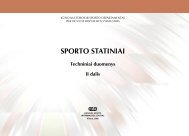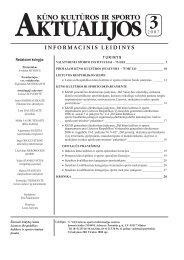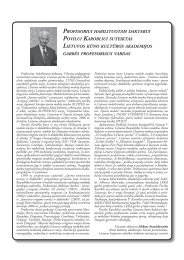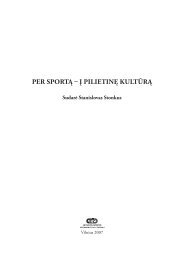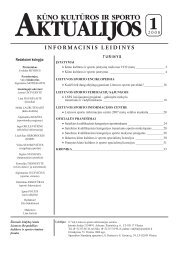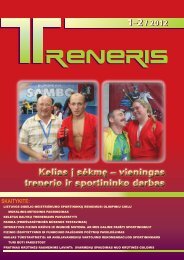Nr. 1 - Lietuvos sporto informacijos centras
Nr. 1 - Lietuvos sporto informacijos centras
Nr. 1 - Lietuvos sporto informacijos centras
Create successful ePaper yourself
Turn your PDF publications into a flip-book with our unique Google optimized e-Paper software.
2010 <strong>Nr</strong>. 1(59)<br />
45<br />
shortening of the small chest and upper trapezius<br />
muscles (Solovjova, 2004).<br />
The lower cross syndrome is characteristic<br />
for athletes of the sports requiring complicated<br />
coordination (eg. ice-hockey and basketball) at high<br />
load on lower extremities: “body falling” forward,<br />
hyper-lordosis of the chest-pelvis area and the<br />
shortening of the pelvic muscles at weakened major<br />
hip muscles and m. rectus abdominis (Travell and<br />
Simons, 1992).<br />
Correction and Prophylaxis<br />
The measurements shown on the athlete profiles<br />
indicate that these changes occur at a young age<br />
during the training process as these athletes are aged<br />
between 14 and 17 years of age. It is my opinion that<br />
for superior athletic performance, athlete posture<br />
profiles should be monitored throughout an athlete’s<br />
development to indicate the speed that these changes<br />
occur. With monitoring of the athletes profiles early<br />
intervention can be made to keep a neutral posture and<br />
allow the athlete to continue competing with a neutral<br />
posture for superior performance and lack of pain.<br />
However, participation in any sport should not<br />
affect an athlete’s posture to the extent that imbalance<br />
leading to pain occurs. If the correct training program<br />
is adopted (one that incorporates strengthening of<br />
antagonistic muscles) a neutral posture should be<br />
maintained throughout the course of an athlete’s<br />
career. This should allow the athlete to maintain<br />
superior athletic performances with minimal injuries<br />
due to posture changes throughout their careers.<br />
Conclusions<br />
1. Athletes of three sports have changes of the<br />
musculoskeletal system, expressed as changes of<br />
posture statics parameters; the greatest distance from<br />
the body vertical line swimmers have in the shoulder<br />
girdle (10.6± 0.4 cm), ice-hockey players – the<br />
highest point of the iliac crest (10.4± 0.7 cm), and<br />
basketball players - the auricle of the ear point.<br />
2. The upper cross syndrome is characteristic for<br />
swimmers. The spine hyperkyphosis of the chest<br />
part and the shortening of the small chest and upper<br />
trapezius muscles have been shown. The lower cross<br />
syndrome is characteristic for ice-hockey players:<br />
hyper-lordosis and the shortening of the pelvic<br />
muscles of the chest-pelvis area at weakened major hip<br />
muscles and m. rectus abdominis have been stated.<br />
3. Taking the test data as the basis it is possible<br />
to state early posture changes and to carry out the<br />
programme of prophylaxis or correction.<br />
References<br />
1. Janda, V. (1994). Manuelle muskelfunktion diagnostik.<br />
Berlin, Ullstein, Moscow.<br />
2. Kendall, H. O., Kendall, F. P. (1982). Muscles Testing and<br />
Function. The Williams and Wilkins company.<br />
3. Solovjova, J. (2004). Jauno peldētāju balsta kustību aparāta<br />
agrīno traucējumu analīze. In: Teorija un prakse skolotāju<br />
izglītībā II. Starptautiskā zinātniskā konference, Rīga, 5.<br />
4. Solovjova, J. (2004). Muscular imbalance in young<br />
swimmers: reasons, prevention of damages. In: Scientific<br />
management of high performance athletes training. 7th<br />
International Sport Science Conf. Vilnius (12-13).<br />
5. Solovjova, J., Upītis, I. (2008). Jauno sportistu<br />
morfofunkcionālā adaptācija fiziskām slodzēm. LSPA<br />
zinātniskie raksti: 2007, 166-175.<br />
6. Vasilyeva, L., Michailov, V. (1995). Electromyographic<br />
substantion of muscle weakness. In: International College<br />
of Applied Kinesiology Europe,. 104-117, London.<br />
7. Travell, J., Simons, D. (1992). Myofascial pain and<br />
disfunction the trigger points. Manual. Williams and<br />
Wilkins, 154-165.<br />
8. Васильева, Л. Ф. (1996). Визуальная диагностика<br />
нарушений статики и динамики опорно-двигательного<br />
аппарата человека. Иваново: МИК. 19-39.<br />
9. Васильева, Л. Ф. (1999). Мануальная диагностика и<br />
терапия (клиническая биомеханика и патобиомеханика).<br />
Руководство для врачей. СПб.: ИКФ Фолиант.145-151.<br />
10. Васильева, Л. Ф. (2002). Нейрофизиологическое<br />
обоснование функциональной слабости мышц.<br />
Приклaдная кинезиология: 1, 19-25.<br />
11. Васильева, Л. Ф. (2002) Гигиена поз и движений.<br />
Приклaдная кинезиология: 1, 53-56.<br />
12. Иваничев, Г. А. (1999). Мануальная медицина. Москва:<br />
Медицина, 48-56.<br />
13. Коган, О. Г., Шмидт, И. Р., Васильева, Л. Ф. (1986).<br />
Визуальная диагностика неоптимальности статики и<br />
динамики. Мануальная медицина: 3, 85- 92.<br />
14. Левит, К.( 1997). Мануальная терапия в рамках врачебной<br />
реабилитации. ВГМУ им.Н.И. Пирогова, 191–195.<br />
Jauno sportininko griaučių raumenų sistemos morfofunkciniai pakitimai<br />
Siekiant ištirti specifinių laikysenos pakitimų<br />
poveikį, buvo testuojami 59 trijų <strong>sporto</strong> šakų 14–17 metų<br />
sportininkai. Vizualinei diagnostikai buvo taikomas<br />
Doc. dr. Jelena Solovjova, doc. dr. Imantas Upitis, prof. dr. Juris Grantas<br />
Latvijos kūno kultūros akademija<br />
Santrauka<br />
L. Vasiljevos (1996), funkciniam raumenų tyrimui –<br />
V. Jando (1994) ir H. Kendallio, F. Kendall (1982) metodai.<br />
Vadovaujantis šiais metodais buvo sukurta diag-



